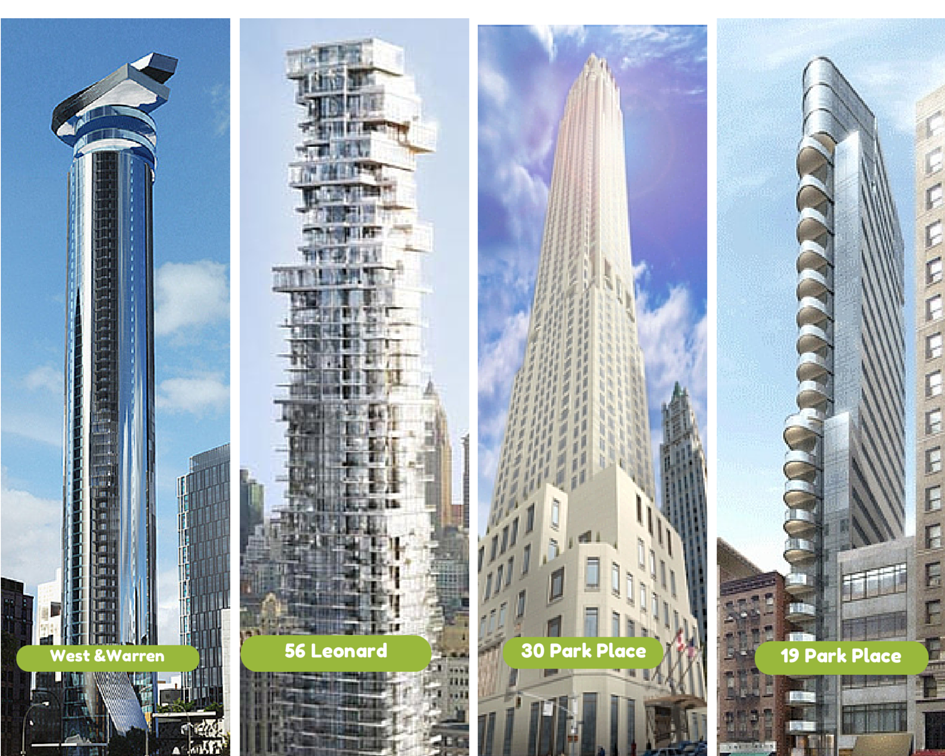by Lynn Ellsworth
Here in Tribeca we can see on a daily basis how the very powerful and deep-pocketed special interests of “Big Real Estate” are carving up what is left of Tribeca into absurdly tall skyscrapers intended for the world’s wealthiest people.
But you knew that already. You even knew it to be happening in other neighborhoods all over New York City. What you might not have known – unless you were watching closely during summer vacation of 2013 – is that all of you, even those of you living in the historic districts, are helping to pay for it.
What am I talking about? I am referring to the public subsidies we see for the so-called “Jenga” Building at 56 Leonard as well as for 30 Park Place and other towers in Manhattan. 56 Leonard is rising on a small lot smack on the border of Tribeca East and Tribeca West historic districts, dwarfing 19th century mercantile buildings all round it. 30 Park Place is Larry Silverstein’s unnecessary skyscraper that will overshadow our city’s greatest landmark, the Woolworth Building. The corner of West and Warren Street will soon house the world’s tallest apartment building. And the eyesore known as 11 Park Place is half-built.
How did this happen?
The challenge will be to connect the dots, which I can only hope that U. S. Attorney’s office is now doing with as much vigor and expansiveness as they can muster. Remember that the U.S. Attorney’s Office for the Southern District promised to take over the job of that bizarrely aborted investigation into New York government corruption known as the “Moreland Commission.”
And that is where our story begins.
Are these Dots Connected?
Dot 1: Last August of 2013, Common Cause published the New York Moreland Commission’s data on the extent of the Real Estate Board of New York’s (REBNY’s) financing of both Albany politicians and New York City politicians. The money – at least $12 million since 2005- was channeled through a variety of means: limited liability partnerships, “housekeeping accounts” of the State Democratic Committee, and political action committees such as “Jobs for New York” and the “Committee to Save New York”. These entities were either REBNY creations or almost completely financed by REBNY members.
Dot 2: As reported in the New York Times, the Moreland Commission on Corruption then tried to subpoena REBNY in 2013, as well as specific REBNY members that included Larry Silverstein. Their interest was in the efforts of Big Real Estate to obtain 421(a) tax abatement deals out of our politicians. But our Governor stepped in and stopped that. He halted the subpoenas and soon thereafter dismantled the Moreland Commission.[1] Why? As New York University’s Brennan Center for Justice noted: “the Commission uncovered multiple e-mails from lobbyists and others advising their clients they needed to make five-figure donations to get legislation passed or killed. These are amounts that exceed what many New Yorkers earn in a year.” One of Silverstein’s donations was for $200,000.
Dot 3: A law was passed in January of 2013 in Albany. The law is Bill Number A.3354. It concerns tax incentives for real estate developers, ostensibly with a few good things like protecting Loft Law tenants. But, there were many deadly Trojan Horses in it, such as one for Larry Silverstein’s monolithic skyscraper (among many others). The bill refers to Silverstein’s building as Block 123, Lot 10, also known as the lot behind the Woolworth. The bill granted an exemption to Silverstein from rules forbidding such towers in Manhattan to receive 421(a) tax abatements. It means that the people who move into Silverstein’s tower will have massively reduced tax bills for ten years. In exchange for that specific legal exemption, our lawmakers told Larry Silverstein that he must build at least nine million dollars worth of affordable housing somewhere else. Yes, you heard that right, $9 million, and not in Tribeca. Is that a lot? Well, let’s see. If you divide that figure by the average cost of building affordable housing, that $9 million makes for a pathetic 36 affordable units! Am I kidding? Alas, I wish I were. Mr. Silverstein must have loved that deal. He gets to contribute what for him is chump change to various legislators with one hand and then on the other he is allowed to cut off light all around us in Tribeca and destroy iconic views of the Woolworth that New Yorkers have enjoyed for one hundred years, all while making billions in profits. And our elected officials in Albany were fully complicit. And to add insult to injury, REBNY has so little shame that it continues to spout foaming-at-the-mouth nonsense claiming that one of our city’s greatest assets, its historic districts, stands in the way of them building MORE towers.
Dot 4: Astonishingly, the building at 56 Leonard in Tribeca also got a 421(a) tax abatement as well. It is so tall that it will be seen far out in the Atlantic. It was financed by a partnership of Goldman Sachs, Bank of America, Hines Real Estate, and the Alexico Group. Buyers are paying on average $5,213 a square foot there, one unit went for $18 million, and the storage units sell for more than a house in Queens. It is generating for the developer about a 90% gross profit margin, and over $2 billion in gross profits. The tax abatements mean the hyper-rich buyers will get a reported 76% reduction on their taxes for ten years.
Even if it is not legally “corruption” (but ought to be), it is still a direct “takings” of the public good
Well, I pay $20,000 a year in real estate taxes for my quite small apartment in Tribeca West Historic District. The new owner of the penthouse at 56 Leonard paid $47 million for his apartment and he will pay about less than I do, $16,500 a year in real estate taxe to be specific (from the Times article). How can this be? His penthouse is worth about 20 times my the value of my apartment and is most certainly ten times the size of my place, but I still pay more. Moreover, that tower damages the historic district I decided specifically to move into years ago. It shadows the streets of our historic district, putting those of us in mid-rise historic Tribeca into a kind of dark Bladerunner world.
All of this adds up to a developer-imposed “takings” of the public good. A normal citizen might then wonder: under what concept of justice or even urban planning are these buildings even allowed to go up? None that make any sense as far as I can see.
Any Solutions at Hand?
I cannot see quick remedies for the deal-making between our politicians and Big Real Estate. Of course, we can sign petitions for campaign finance reform and try to overturn Citizens United. But that is a long-term political slog. We can also cheer on the U.S. Attorney General for the Southern District’s continued investigations of corruption. Go Mr. Bharara!
But really. It doesn’t feel like enough. Our government feels stolen. Our city as well. Shouldn’t we be marching with pitchforks somewhere? Alas, we Yeomen of the Republic don’t actually have pitchforks these days, so we need another strategy. Perhaps we should borrow a page from California voters and go on a tax strike. Residents of Tribeca’s historic districts pay New York City about $79 million in various taxes a year. Maybe the City might feel the absence of that money if we withheld it. If that works, perhaps I’d also go for restorative justice: those half-built buildings at 56 Leonard and 30 Park Place could be dismantled and turned into public parks. Now that would surely be a better use of the public’s money than subsidizing the bank accounts of Big Developers and the tax bills of Russian oligarchs.
Regulatory Capture and our Founding Fathers
“Regulatory capture” is a variety of political corruption. It happens when a special interest group ends up so influencing an agency of government that the agency no longer acts in the public interest. Here we might as well be smart and cast a skeptical eye upon our Department of City Planning that creates the zoning that lets this happen. Or maybe as well the Empire State Development Corporation or the Housing and Urban Development Agency that hands out tax abatements. And obviously, our politicians need to prove they are not in this.
The economist George Stigler describes the economic theory behind regulatory capture in his article, “The Theory of Economic Regulation” back in 1971. Of course, Mancur Olson, another great economist, wrote about how special interests can come to capture not just regulatory bodies, but larger parts of government in his famous 1965 book, The Logic of Collective Action. But as usual, economists arrived late to the game. Our founding fathers knew capture was a problem and debated how they might construct our government to manage it. George Mason (whose beautifully hand-crafted house I recently visited in Virginia) was the author of the Virginia Declaration of Rights. He said in a public debate: “ if we do not provide against corruption, our government will soon be at an end.[2]”
But we residents of Tribeca don’t need the intellectual explanations. We live regulatory capture here every day. It rises in our midst and treats us ordinary homeowners as tax serfs rather than citizens. And foot by rising foot it blocks our light, our 100-year-old views and erodes the beauty and public values of the historic districts we fought so hard to obtain.
Sources:
New York Times, “Cuomo’s Office Hobbled Ethics Inquiries by Moreland Commission” July 23, 2014. And “How the Rich Get A Big Real Estate Tax Break”, published July 12, 2013.
The Real Deal, July 12, 2013, “Buyers at Extells One57 set to receive a 94% tax break”, and April 27, 2014, “56 Leonard Is Shaping Up Fast”, and April 2013, “56 Leonard Back From the Dead,” and June 16, 2014, “Developers Using Loophole to funnel donations to Cuomo”, and July 23, 2013, “Anti-Corruption Panel Clashed Over Real Estate Influence on Cuomo”
New York State Assembly, Law A3354, sections 10 and 11, Lines 46 of Section 10, Lines 1-37 of Section 11.
Common Cause, August 5, 2013, “Moreland Monday Analysis of REBNY Contributions Raises Serious Issues for Commission to Consider”
The Commission to Investigate Public Corruption, Preliminary Report, December 2, 2013.
Crains New York Business, August 11, 2013, “Breaks for Posh Pads Cause Stir”
George Stigler, “The Theory of Economic Regulatio”, The Bell Journal of Economics and Management, Vol 2, No 1. , Spring 1971.
[1] Common Cause states “In the longer term since 2005, REBNY and its leadership have given over $11.7 million to candidates and committees in the State Senate, overwhelmingly concentrated to Republicans. REBNY has given less to the State Assembly where party control is safe for the Democrats: $2.1 million in total, with 84% going to Assembly Democrats. The return on REBNY’s political investment in Albany is crystal clear: New York City rent regulations remain weak, while multi-billion dollar subsidies like the 421-a and J-51, continue to grow each year.”
[2] Notes of Yates, Records of the Federal Convention of 1787, Vol 1, e. Max Farrand (new Haven, CT. Yale University Press, 1911). Cited in Teachout’s book, “Corruption in America”.



